It’s time to fix the cobblestones on Greenwich
I’ve had a post simmering on the cobblestones for almost two and a half years (what? how?) — I first asked the Department of Transportation about the plans for Greenwich Street in September 2019. I guess once the pandemic hit it seemed silly to write about street repairs. But now it’s been on my mind again, since I made the fatal mistake of driving down Greenwich with a thermos of hot tea. And since I took a good look at Staple Street and decided it’s time for an overhaul there as well.
But the real problem child — and the priority — is Greenwich, where the road bed at this point has waves, and the gaps between the stones are so large they can trap a Citi Bike tire. The asphalt patches make it even worse. I would say it has gotten to be dangerous even for someone walking in flats, and neighbors report the sound of cars rattling along has become a din.
The DOT did a great job restoring the intersections at Laight and Greenwich, but that was two years ago, in January 2020. They upgraded the crosswalks with laser-cut granite cobblestones that are smooth and flat so they are ADA accessible. And the Department of Design and Construction is repairing and restoring the roadway (and has been for years) at Vestry and Hudson. Desbrosses was repaired by the developers of 70 Vestry, and the new hotel will repair its portion of the roadbed on Desbrosses as well.
So that leaves us with Greenwich from Canal to Hubert as the main project, and if I were prioritizing a #2, Staple. (The stone side streets of Hubert, Beach, N. Moore, Franklin, Harrison and Jay seem in better shape to me, but residents there might argue…)
There are neighbors who have dug into the technology behind cobblestones — or Belgian block, as they are actually called — and I have dug around a bit to see what I could learn. (See below.) They are generally set on a concrete roadbed and sometimes use mortar between them — but more often, they are just squeezed together. The signature cut is wider at the bottom and narrower at the top, so you see the gap but in fact at their base they fit together. A dry mortar dust can be swept into the cracks and eventually set with rain fall.
“It’s good for the economy — that’s why movie shoots love it here, and it’s great for our restaurants and businesses,” says Bill Paulsen who lives on Greenwich and has been tracking the deterioration of the street below his apartment, but wants to see the street restored and not paved over. “It makes our neighborhood unique.”
* I will continue calling them cobblestones, since the “Belgian block streets of Tribeca” doesn’t have the same ring. But cobblestones are irregular in shape, naturally formed and set in sand — think England circa 1600. Setts, or Belgian block, are quarried and shaped into rectangles. That is what was used in New York starting in the 17th Century; in the mid 19th Century, concrete and later asphalt covered the blocks.







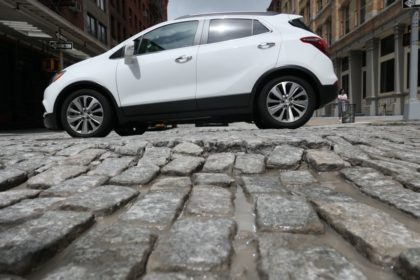
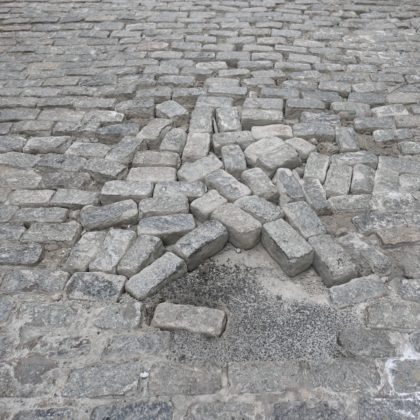
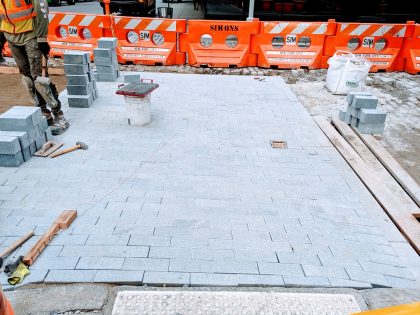
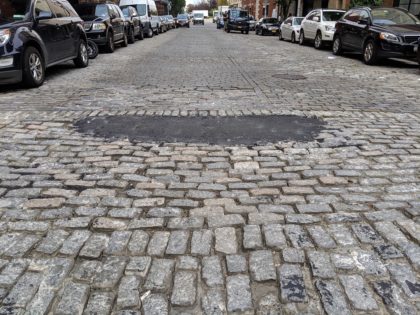
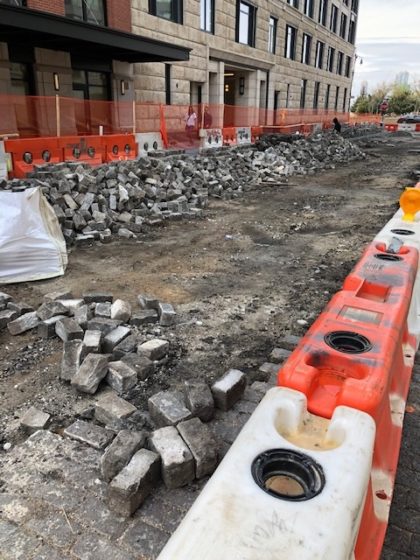
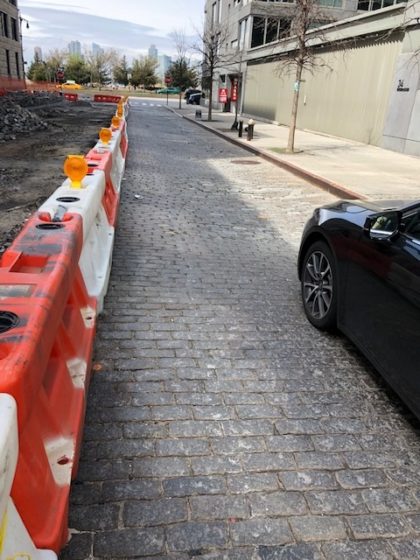
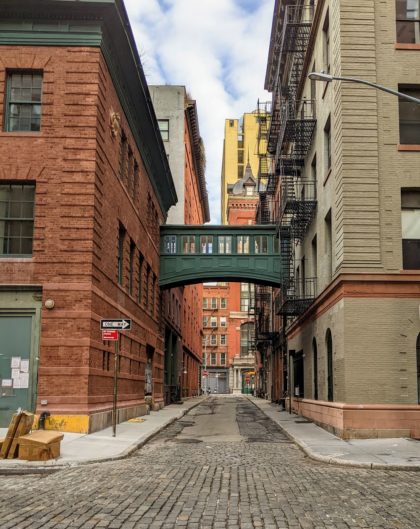
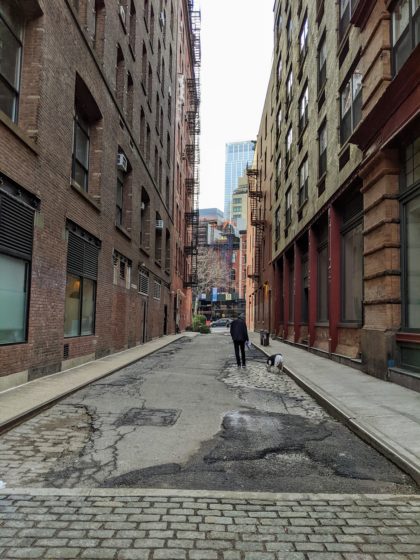






YES. It is ridiculous how bad Greenwich has gotten and my Uber driver once said as we turned from Canal onto Greenwich: “these are some of the worst blocks in New York.”
The cobblestones in that area are definitely a disaster, but they’re our disaster!
In all seriousness, there is an ancillary benefit—absolutely nobody speeds. I also have a hunch that drivers avoid Greenwich once they experience how bad it is, which makes the area quieter and nicer (except for the bouncing garbage trucks that sound like they’re going to explode).
If those streets ever get repaired, there should be speed humps. There’s way too much tunnel traffic and out-of-town drivers coming through what is a purely residential area. It goes without saying that keeping Belgian blocks for the entire stretch is absolutely non-negotiable for a historic district.
I agree with @person. How about, in addition, duplicating on Greenwich the 18-inch metal (?) strip DOT installed awhile ago on Varick immediately south of Canal. It’s a godsend for cycling.
I often bike on that part, and I believe it is a smooth stone like granite?
Ah, right, granite! Thanks Robert. I’ll try to find out how that strip came to be (unless you already know?).
“N. noticed that the tooth-rattlingly cobblestoned patch of Varick alongside Albert Capsouto Park is getting a non-cobblestoned bike lane installed.”
https://tribecacitizen.com/2015/04/01/seen-heard-beaubourg-restaurant-is-now-open/
Why is it “non-negotiable” to keep outmoded road surfaces that endanger vehicles and pedestrians? Does one really want to restore the streets of this then-mercantile area to resemble their genuine, historic 19th century condition? I doubt it.
Per Robin Nagle, anthropologist-in-residence at New York City’s Department of Sanitation since 2006, 19th century NYC streets were a horrid mess.
“[The Department of Sanitation] was created as the Department of Street Cleaning in 1881, and renamed the Department of Sanitation in 1929. But it was actually made effective for the first time in 1895, in that the people who worked for the department actually collected garbage and swept the streets.
“In its early days, the department didn’t really function at all. There are some photographs taken for Harper’s Weekly, before and after photos of street corners in New York in 1893 and then in 1895. And the before pictures are pretty astonishing, people were literally shin-high or knee-high in this muck that was a combination of street gunk, horse urine and manure, dead animals, food waste, and furniture crap.
“Put yourself back in the late 19th century and think about the material world that would have surrounded you in your home. When you threw something out, it wouldn’t go anywhere. It would be thrown in the street.”
From https://www.collectorsweekly.com/articles/when-new-yorkers-lived-knee-deep-in-trash/
“The June 22, 1895, edition of Harper’s Weekly compared photos of the same street corners two years earlier to show what an incredible transformation street cleaning had effected. Via the New York Public Library.”
https://d3h6k4kfl8m9p0.cloudfront.net/uploads/2013/06/harpers-june-22-1895.jpg
Obviously nobody is calling for streets strewn with horse manure and urine in the name of historic authenticity.
We have clean belgian block streets and they should stay that way because they “further the nineteenth century commercial character of the district,” as the LPC determined 30 years ago and as everybody who lives hear knows. They’re beautiful and we’re lucky to have them.
http://s-media.nyc.gov/agencies/lpc/lp/1714.pdf
If you want to see a good example of cobblestones – go to Collister between Hubert and Laight – the east side of the street that has never been dug up. It’s smooth, level and over 20 years old. The cobblestones that went in after the waterpipes dug everything up have been a mess and difficult to navigate with strollers, shopping carts and heels.
Pretty much what I was going to say, but I was going to mention Vestry between Greenwich and Hudson! Seems like all the streets done 80-100 years ago are in better shape than the ones done only a few years ago. What did they do differently, and why can’t they do that today?
Also, not that I would ever admit to it in a court of law, but I feel safer biking the wrong way down Washington from Canal to Hubert than going the legal way down Greenwich…
… which I too have been doing as well, for decades!
Would absolutely love to see Staples St “belgian blocked.” It is the star destination for so many photoshoots and seems a perfect place to restore the historical character of the neighborhood. Plus, there is very little vehicle traffic.
I agree with Carla…one of the most scenic streets in NY has the worst pavement. Staples St. should be repaired. It would bring additional character to a lovely and iconic street. Can’t imagine why it has been neglected for so long. It’s time to do something about it.
The neighborhood is much safer with the awful cobbles. Much. I hate the laight street section. It used to bounce the speeding cars from the tunnel and actually slowed the crazy traffic exiting the tunnel. I would propose badly laid cobbles on Laight and Hudson and a smooth cycle cut. I saw a dog killed on the laight intersection. I doubt he’d have run the red light if he was a regular over the cobbles.
The rebuilt cobblestone streets start off really well done with a proper bed of cement below them. The trouble starts after utility work happens and the concrete bed is not properly restored. The stones aren’t supported and sink as the soil below is compressed or eroded. Greenwich street has become a safety hazard.
Driving down Greenwich Street is like driving on the moon. It’s mind-boggling how long the city neglects such a dangerous situation for so long.
Staple Street also has a drainage problem, with many pools of standing water after a rainstorm.
The City could fix the streets, if they wanted, but they don’t. Look at all the major cities in Europe and other parts of the world. They have cobblestone streets and they are in excellent condition. AND, they’re much older than ours.
How many of those cobblestone streets in European cities are open to car traffic, and how many are really just pedestrian only?
Please check the schedule for Community board#1 Quality of life committee. I brought the situation up again and last meeting the DCC attended and was going to report directly to the DOT. We had someone from our last Mayor’s office come to examine the streets in 2018; nothing happened afterwards! Now, I believe the conversation is becoming more serious because of some fatal situation that occurred on Harrison Street. Someone from the New York Post did an article that hopefully will be posted. (Ukraine situation has postponed it..?) Covid took a toll on everything. But the CB#1 and Someone from Margaret Chin’s office (former City Council member) took a tour with the DOT on some of the streets. A resolution about the stones was sent to DOT in 2016! We can use everyone’s help by attending the CB meetings that occur on video at this point. Quality of Life committee posts their agenda in advance. Please support the cause so it’s not just a few folks talking about it. We need your help.
thanks
Diane Lapson
President
Independence Plaza North tenant Association.
https://nypost.com/2022/02/26/tribeca-residents-fear-cobblestone-nyc-streets/
P.S. Please understand, the cobblestones are not just an eyesore they are a serious danger. The former Mayor’s office said re: Harrison Street – when we discussed how dangerous it was (is) – that people should be crossing the streets at the corner, but that is not always possible and what a foolish comment to make. Aside from getting out of your car on the driver’s side and being on the cobblestones; bicycles cannot make it on the damaged streets so they take to the sidewalks, causing other issues to pedestrians; motorcycles have almost turned over as witnessed by several people I know including myself; and the list goes on. The wear and tear on cars is already well known; a friend had her tire blown out on Varick Street. The city claimed that some of the problems were from “Sink holes” which means we’ve got some bigger problems than just cobblestones if that is true. (Is Tribeca sinking????)
To be continued……. Diane Lapson
There’s nothing dangerous about Belgian blocks. They’ve been used for centuries around the world, they’re beautiful, and they’re a key piece of what makes Tribeca special. People can trip and fall anywhere on anything, potholes happen on asphalt too, etc.
That said, since we both share concerns about public safety, please shovel the IPN sidewalks more effectively when it snows. They’re always an icy, slushy mess—an actual danger, unlike Belgian block streets. There’s a bit of a litter problem too.
Belgium blocks are a historical part of TriBeCa and define it as a historical district. It is imperative to keep this character of TriBeCa. It is beyond imperative to keep this character.
What needs to happen is some sound structural engineering- (just look at Paris, roads in good shape lasting generations). The material of blocks used should emulate the blocks on Staple Street. The CURRENT blocks in being used look more like cut granite – The bricks placed at Greenwich & Vestry are bricks – the kind used in Florida developments and do not represent TriBeCa. These need to be replaced with sound structural materials and block material that represent the history of this unique part of Manhattan. TC if possible, please include a link to CB1 so that all may follow up and be hyper engaged to preserve the integrity of TriBeCa. Appreciation for your neighborhood coverage.
How about Jay Street, Harrison Street, parts of Franklin Street, etc! They’re all terrible. Some have at least a two inch gap between the blocks. I don’t know who laid these blocks but obviously they’ve never been to Europe or South American cities where actual cobble stones are still in use after over 100 years. Who the heck puts the craggy part of the stone upside? No wonder that bikers ride on the sidewalk!
You can also add Varick Street Between Canal and Laight to the list . Thank You Very Much !
Save the cobblestoned streets of Tribeca….. why live here if you want tarmac roads and modern buildings. Lots of other places to live for that in NYC like Hudson Yards.
The other major problem with the streets is it forces bikes and scooters including electric ones onto the sidewalk. I’ve been sideswiped and my daughter was almost hit by people biking at incredible speeds as we step out of our building. Combine that with citibike stations and someone will be killed.
Superfast bikes on sidewalks are dangerous, no question. But tell me precisely how citibike stations add to the danger?